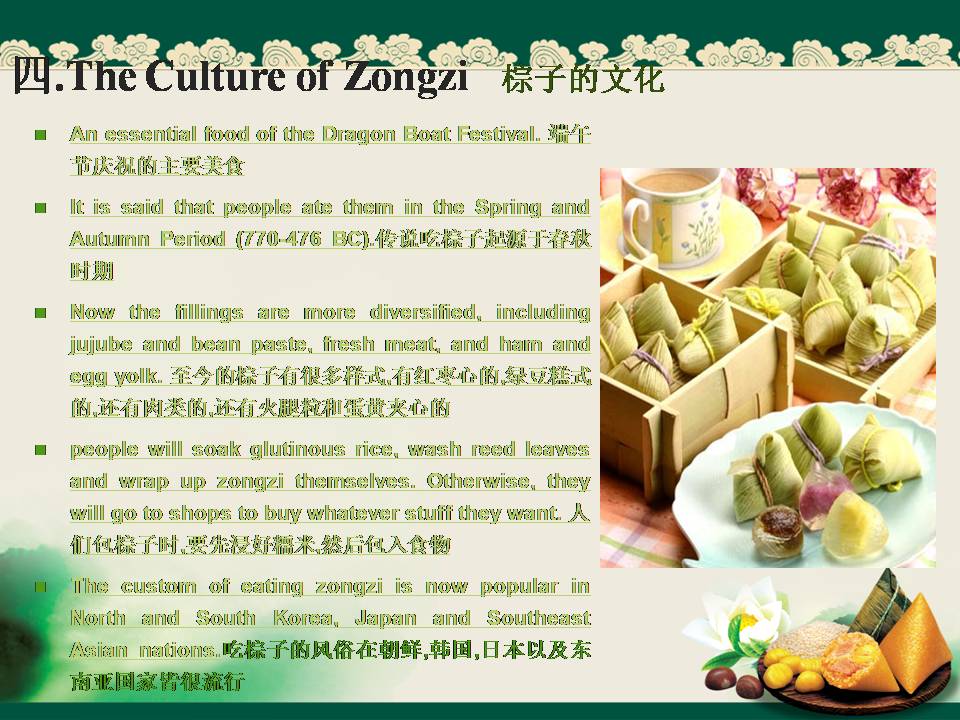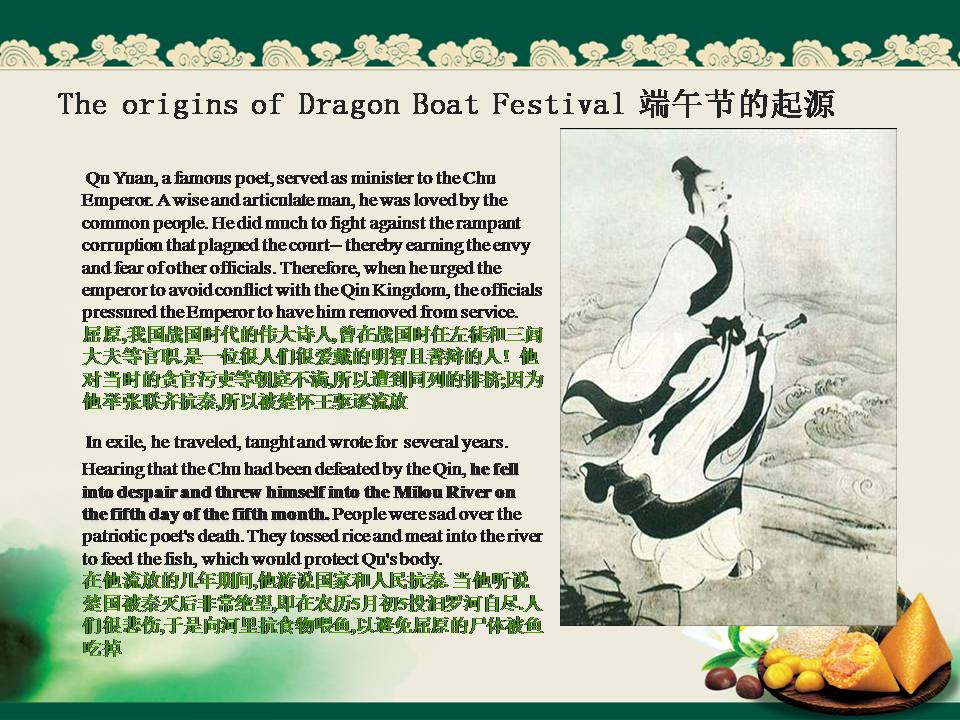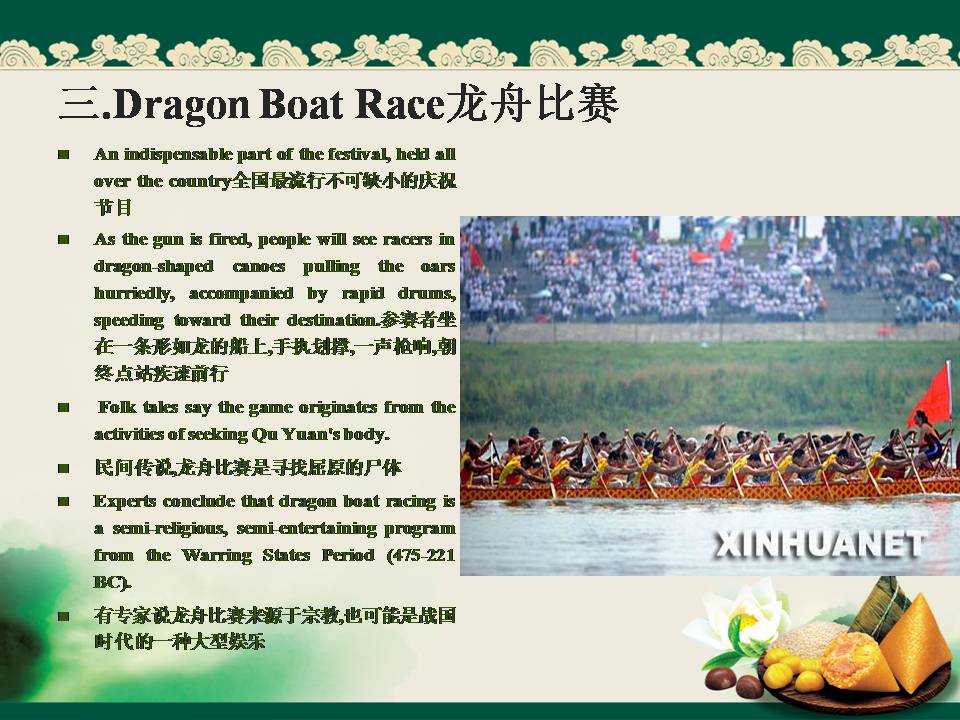【www.gbppp.com--新秀美文】
The custom of Dragon Boat Festival
端午节的习俗
1.Dragon Boat Racing
赛龙舟
Because Chuese don’t want virtuous minister Qu Yuan died at that time, so there are a lot of people boating to save him after he jumping into river.
当时楚人因舍不得贤臣屈原死去,于是有许多人划船追赶拯救。
2.Eating zongzi on Dragon Boat Festival
端午节吃粽子
People boiled sticky rice or steamed reed on May 5 and then jumped it into the river, to sacrifice to Qu Yuan, with bamboo tube array sticky rice rolls for fear of fish to eat, gradually reed leaves maize replacing bamboo tube.
人们在五月五日煮糯米饭或蒸粽糕投入江中,以祭祀屈原,为恐鱼吃掉,故用竹筒盛装糯米饭掷下,以后渐用粽叶包米代替竹筒。
3.Wearing perfume satchel
佩香囊
Children wear perfume satchel on the Dragon Boat Festival can avoid devil. 端午节小孩佩香囊,避邪驱瘟之意。
4.Eating eggs
吃蛋
Some areas will boil tea eggs and brine eggs to eat on the Dragon Boat Festival. Eggs are henapple, duck eggs, goose egg. Painted red on eggshell, with colorful net bags, hanging in a child's neck, for blessing children, and hopping them are safe.
一些地区,端午节要煮茶蛋和盐水蛋吃。蛋有鸡蛋、鸭蛋、鹅蛋。蛋壳涂上红色,用五颜六色的网袋装着,挂在小孩子的脖子上,意为祝福孩子逢凶化吉,平安无事。
5.Drinking Realgar Wine
饮雄黄酒【端午节英语】【端午节英语】
This custom is very popular in the Yangtze river area.
此种习俗,在长江流域地区的人家很盛行。
6.Wash all diseases
游百病
This custom is prevalent in part of Guizhou province on Dragon-Boat festival custom. Some people will go to swim as well.
此种习俗,盛行于贵州地区的端午习俗有些人也会去游泳。
7.Eat twelve red
吃十二红
Gaoyou and other places have the tradition of eating "twelve red". Twelve red refers to oil shrimp, Fried amaranth, salted duck egg yellow, cinnabar tofu and so on.
高邮等地有吃“十二红”的习俗。十二红指油爆虾、炒红苋菜、咸鸭蛋黄、朱砂豆腐等。
端午节英语怎么说? 端午节(Duanwu Festival/Tuen Ng Festival)是中国传统节日(traditional holiday),也是法定节日(statutory holiday)。中国大陆在2008年将端午节列为法定节日。目前在大陆、香港、澳门与台湾它都是公共假日(public holiday)。在英文中,它的常见名称是龙舟节(Dragon Boat Festival),这是根据(after)节日的一项主要活动来命名的。按照历法精确译法应该是Solar Maximus Festival。指夏至(summer solstice)或北半球(northern hemisphere)一年中最长的一天。
端午节在中国农历的五月初五(the fifth day of the fifth month of the Chinese calendar),所以也叫重五节(Double Fifth Festival)。主要庆祝活动(celebration)包括吃粽子
(zongzi/sticky rice wrap/sticky rice dumpling with red bean filling/sticky rice ball)、喝雄黄酒(realgar wine)与赛(racing)龙舟。粽子用苇叶(reed leaf)或竹叶(bamboo leaf)包裹糯米(sticky rice)制成带棱角(angular)的形状。其它活动还有悬挂(hang)钟馗像(icon of Zhong Kui)【神话中的保护神(mythical guardian figure)】、佩戴(wear)香囊(perfumed medicine bag)、悬挂艾蒿(mugwort)与菖蒲(calamus)、画符(writing spell)等。主要目的是驱邪(ward off evil)或祛病(ward off disease)。
世界上普遍认为端午节起源于(originate)于古代中国。中国有很多民间传统(folk tradition)、信仰(belief)或解释说法(explanatory myth)与庆
祝这个节日(observance)有关。最常见的是把该节日与周朝(Zhou Dynasty)战国时期(Warring States period)楚王(King of Chu)的学者(scholar)兼大臣(minister)——屈原(Qu Yuan)之死联系在一起。他也是诗人(poet)与政治家(statesman)。因此在民国时期(Republic of China),它也叫诗人节(Poet's Day)。大陆目前叫他‘爱国诗人(patriotic poet)’。
端午节在日本叫Tango no Sekku (端午の節句)。在日本改用公历(Georgoriian calendar)后日期改为五月五日(May
5)。日本也叫Kodomo no Hi,即儿童节(Children's Day)。历史上也叫男孩节(Boy's Day)或旗节(Feast of Banners)。
在朝鲜端午节是法定节日。它也是韩国主要传统节日之一,叫Dano/Surit-nal。联合国教科文组织(UNESCO)确定韩国端午节活动之一的江陵端午祭(Gangneung Dano Festival )为人类口头与非物质文化遗产杰作(Masterpieces of the Oral and Intangible Heritage of Humanity)。端午节在越南叫Tet Doan Ngo。
端午节的由来(中英文)
The Dragon Boat Festival, also called Double Fifth Festival, is celebrated on the fifth day of the fifth moon of the lunar calendar. It is one of the most important Chinese festivals, the other two being the Autumn Moon Festival and Chinese New Year.
端午节,又称为五五节,因为端午节是在农历的五月五日,是三个重要的中国节庆之一,其他两个分别是中秋节和农历新年。
The origin of this summer festival centers around a scholarly government official named Chu Yuan. He was a good and respected man, but because of the misdeeds of jealous rivals he eventually fell into disfavor in the emperor's court.
这个节日的由来是古代中国有一位博学多闻的官吏屈原,他是一位爱民而且又受到尊崇的官吏,但是由於一位充满嫉妒的官吏陷害,从此在朝廷中被皇帝所冷落。由於无法获得皇帝的重视,屈原在忧郁的情况下投汨罗江自尽。
Unable to regain the respect of the emperor, in his sorrow Chu Yuan threw himself into the Mi Low river. Because of their admiration for Chu Yuan, the local people living adjacent to the Mi Lo River rushed into their boats to search for him while throwing rice into the waters to appease the river dragons.
Although they were unable to find Chu Yuan, their efforts are still commemorated today during the Dragon Boat Festival.
由於对屈原的爱戴,汨罗江畔的居民匆忙的划船在江内寻找屈原,并且将米丢入汨罗江中,以平息汨罗江中的蛟龙。即使他们当时并没有找到屈原,但是他们的行为,直到今天在端午节的时候,仍然被人们传颂纪念著。
端午节风俗习惯
Dragon Boat race Traditions At the center of this festival are the dragon boat races. Competing teams drive their colorful dragon boats forward to the rhythm of beating drums. These exciting races were inspired by the villager's valiant attempts to rescue Chu Yuan from the Mi Lo river. This tradition has
remained unbroken for centuries.

Tzung Tzu A very popular dish during the Dragon Boat festival is tzung tzu. This tasty dish consists of rice dumplings with meat, peanut, egg yolk, or other fillings wrapped in bamboo leaves. The tradition of tzung tzu is meant to remind us of the village fishermen scattering rice across the water of the Mi Low river in order to appease the river dragons so that they would not devour Chu Yuan.
Ay Taso The time of year of the Dragon Boat Festival, the fifth lunar moon, has more significance than just the story of Chu Yuan. Many Chinese consider this time of year an especially dangerous time when extra efforts must be made to protect their family from illness. Families will hang various herbs, called Ay Tsao, on their door for protection. The drinking of realgar wine is thought to remove poisons from the body. Hsiang Bao are also worn. These sachets contain various fragrant medicinal herbs thought to protect the wearer from illness.
风俗习惯端午节最重要的活动是龙舟竞赛,比赛的队伍在热烈的鼓声中划著他们多彩的龙舟前进。这项活动的灵感是来自於当时汨罗江畔的居民,在江中划船救屈原,而这个传统也一直保持了数个世纪。在端午节时受欢迎的食物就是粽子,粽子是以米包著肉、花生、蛋黄及其他材料,再以竹叶包裹。而粽子的传统则来由於汨罗江边的渔夫,将米丢入江中平息江中的蛟龙,希望他们不要将屈原吃掉。农历的五月,也就是端午节的这个时节,对中国人而言,除了屈原的故事还有许多其他重要的意义。许多中国人相信五月是一年中容易引发疾病的危险时节,因此必须有许多防备家人生病的措施。许多家庭会将一种特别的植物-艾草挂在门口,作为保护之用,而人们也会挂带香包,它是以含有多种香味的药用植物所做成,也可以保护人们远离疾病。
农历五月初五端午节,是我国最大的传统节日之一。端午亦称端五,“端”的意思和“初”相同,称“端五”也就如称“初五”;端五的“五”字又与“午”相通,按地支顺序推算,五月正是“午”月。又因午时为“阳辰”,所以端五也叫“端阳”。五月五日,月、日都是五,故称重五,也称重午。此外,端午还有许多别称,如:夏节、浴兰节、女儿节,天中节、地腊、诗人节等等。
端午节的别称之多,间接说明了端午节俗起源的歧出。事实也正是这样的。关于端午节的来源,时至今日至少有四、五种说法,诸如:纪念屈原说;吴越民族图腾祭说;【端午节英语】
起于三代夏至节说;恶月恶日驱避说,等等。迄今为止,影响最广的端午起源的观点是纪念屈原说。在民俗文化领域,我国民众把端午节的龙舟竞渡和吃粽子都与屈原联系起来。传说屈原投江以后,当地人民伤其死,便驾舟奋力营救,因有竞渡风俗;又说人们常放食品到水中致祭屈原,但多为蛟龙所食,后因屈原的提示才用楝树叶包饭,外缠彩丝,做成后来的粽子样。
端午节的习俗主要有:吃粽子于门上插艾或菖蒲驱邪,系长命缕,饮雄黄酒或以之消毒,赛龙舟等等。 粽子又叫“角黍”、“筒粽”,前者是由于形状有棱角、内裹粘米而得名,后者顾名思义大概是用竹筒盛米煮成。端午节吃粽子,在魏晋时代已经很盛行。这种食品是在每年端午和夏至两个节日里食用。粽子还是一种节日往来的礼品。到了唐宋时期,粽子已极为有名,市场上常有粽子卖。现在,我们过端午节仍然免不了要吃几只粽子。粽子有不少花样,有南北之别,东西之分。南方常用红枣、花生、咸肉等混在糯米中制成,也多见不杂别的食品,而去品味粽叶的清香的;北方多以枣、果脯等作为粽子的馅心。小小的粽子,似乎已经成了中国传统的象征,在人们心中占据着一定的位置.过去端午节还有躲午的习俗,此种习俗源于一种信仰,即:五月为“恶月”,瘟疮蔓延,重五是个不吉利的日子,所以父母都于是日将未满周岁的儿女带往 外婆家躲避,以逃脱灾祸,故称躲午。这无疑是古代科学不发达而产生的观念,因为五月酷暑将至,蚊虫滋生,在没有医疗卫生设备的民间,容易发生传染病,遂给人们带来一种恐惧心理,于是产生躲午习俗,如今这一节日的一些古老习俗已经随着社会变迁而消失了,但吃粽子、赛龙舟等习俗仍然流行。


The Dragon Boat Festival, also called the Duanwu Festival, is celebrated on the fifth day of the fifth month according to the Chinese calendar. For thousands of years, the festival has been marked by eating zong zi (glutinous rice(糯米)wrapped to form a pyramid using bamboo or reed leaves) and racing dragon boats.
The festival is best known for its dragon-boat races, especially in the southern provinces where there are many rivers and lakes. Thisregatta(赛舟会)commemorates the death of Qu Yuan , an honest minister who is said to have committed suicide by drowning himself in a river. Qu was a minister of the State of Chu situated in present-day Hunan and Hubei provinces, during theWarring States Period(475-221BC)(战国时期). He was upright, loyal and highly esteemed for his wise counsel that brought peace and prosperity to the state. However, when a dishonest and corrupt prince vilified Qu, he was disgraced and dismissed from office. Realizing that the country was now in the hands of evil and corrupt officials, Qu grabbed a large stone and leapt into the Miluo River on the fifth day of the fifth month. Nearby fishermen rushed over to try and save him but were unable to even recover his body. Thereafter, the state declined and was eventually conquered by the State of Qin.
The people of Chu who mourned the death of Qu threw rice into the river to feed his ghost every year on the fifth day of the fifth month. But one year, the spirit of Qu appeared and told the mourners that a hugereptile(爬行动物)in the river had stolen the rice. The spirit then advised them to wrap the rice in silk and bind it with five different-colored threads before tossing it into the river.
During the Duanwu Festival, a glutinous rice pudding called zong zi is eaten to symbolize the rice offerings to Qu. Ingredients such as beans,lotus seeds(莲子),chestnuts(栗子), pork fat and the golden yolk of a salted duck egg are often added to the glutinous rice. The pudding is then wrapped with bamboo leaves, bound with a kind of raffia and boiled in salt water for hours.
The dragon-boat races symbolize the many attempts to rescue and recover Qu's body. A typical dragon boat ranges from 50-100 feet in length, with a beam of about 5.5 feet, accommodating two paddlers seated side by side.
A wooden dragon head is attached at the bow, and a dragon tail at thestern(船尾). A banner hoisted on a pole is also fastened at the stern and the hull is decorated with red, green and blue scales edged in gold. In the center of the boat is a canopied shrine behind which the drummers,gong(铜锣)beaters andcymbal(铙钹)players are seated to set the pace for the paddlers. There are also men positioned at the bow to set off firecrackers, toss rice into the water and pretend to be looking for Qu. All of the noise and pageantry creates an atmosphere of gaiety and excitement for the participants and spectators alike. The races are held among different clans, villages and organizations, and the winners are awarded medals, banners, jugs of wine and festive meals.
端午节传说
端午节来源于屈原端午节(Dragon Boat Festival),农历五月初五,又名端阳,端是“开端”、“开始”的意思。初五可以称为端五。农历以地支纪月,正月建寅,二月为卯,顺次至五月为午,因此称五月为午月,“五”与“午”通,“五”又为阳数,故端午又名端五、重五、端阳、中天、重午、午日,此外一些地方又将端午节称之为五月节、艾节、夏节。从史籍上看,“端午”二字最早见于晋人周处《风土记》:“仲夏端午,烹鹜角黍”。
端午节是我国汉族人民的传统节日。这一天必不可少的活动逐渐演变为:吃粽子,赛龙舟,挂菖蒲、艾叶,薰苍术、白芷,喝雄黄酒。据说,吃粽子和赛龙舟,是为了纪念屈原,所以解放后曾把端午节定名为“诗人节”,以纪念屈原。至于挂菖蒲、艾叶,薰苍术、白芷,喝雄黄酒,则据说是为了压邪。
民俗专家称,端午节始于中国的春秋战国时期,至今已有2000多年历史.时至今日,端午节仍是中国人民中一个十分盛行的隆重节日。端午节现为国家法定节假日。国家非常重视非物质文化遗产的保护,2006年5月20日,该民俗经国务院批准列入第一批国家级非物质文化遗产名录。
本文来源:http://www.gbppp.com/yc/416586/
推荐访问:端午节英语简介 端午节英语资料